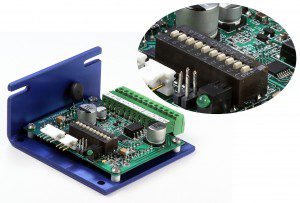
Dual in-line package or DIP switches are manual electronic switches that, along with other switches in one package, form one unit. They usually mount on printed circuit boards through pins. Some common types of DIP switches include rotary, slider and rocker switches. Through them, end users configure circuit boards or controllers for the application at hand. In the case of rocker DIP switches, the setting is either an on or off position. In the case of rotary DIP switches, a dial can set to any number in an array of positions.
Using DIP switches gives designers various control options over a stepper motor. Some DIP switches let the designer change the step size, current, speed and more. Advantages of DIP switches include no need to use software programs to configure a stepper drive to operate a motor. Simply set the switches in the desired position and the motor will run in that manner. That in turn eliminates the need to connect the drive to a computer.
Another advantage is that it’s not necessary to power up the system to know its state. The positions of the DIP-switch toggles or dial indicates what the drive is set to do. DIP switches are also inexpensive and easy to use and incorporate into designs.
Despite these advantages, DIP switches do have drawbacks. Where space is a concern, DIP switches can be bulky, especially in designs that necessitate many setting options. Remote configuration is impossible, as the switches require manual (physical) adjustment.
One alternative to DIP switches is software control, which requires a computer in conjunction with a drive. This means the end user must either write a program to configure the drive, or use a program provided by the manufacturer. This is why as much as industries move toward configuring via software, DIP switches — with their simplicity and ruggedness in a low-cost setup — remain a hardware element of configuration.
Other physical alternatives to DIP switches include pin jumpers, electronic buses and soldered bridges. Soldered bridges are suboptimal because they require soldering and unsoldering to make any changes. Pin jumpers are less expensive than DIP switches and semi-permanent, but they are also larger and are easy to lose. Electronic buses are small and highly configurable, but require a computer. What’s more, electronic buses are also a potential confusion point because hardware and software errors may now appear to be the same thing.
Tip: weigh the applications’ unique requirements against the pros and cons of all the available options. Also contact the stepper-drive manufacturer with questions.
For more information, read:
Technical article: Choosing Configuration Jumpers
Kollmorgen’s webpage on the P6000 stepper drive (and its switches)
US Digital’s webpage on its MD2S microstepping motor drive
Motion Control Tips: R325P Stepper Drive from Lin Engineering
Motion Control Tips: Techno announces new multi-axis stepper controller


Leave a Reply
You must be logged in to post a comment.